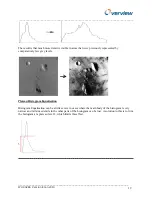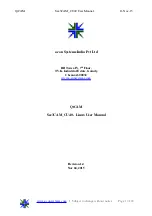
__________________________________________________________________________________
__________________________________________________________________________
IPU 40285 Version E Jan 2013
17
The offset required in this case is (max + min)/2, which is an approximation to the median, (the real
median is computationally intensive to calculate) so we call this the median contrast scheme.
The median contrast scheme is strongly affected by targets appearing at either the hot or cold end of
the detector’s output range as shown in the following histogram which has two components separated
(bimodal histogram). This makes it very obvious that a hot target is in the scene.
This can be an advantage or disadvantage depending upon the requirements of the application. If the
target is a person against a 20C background, this can work well. However, if an object enters the scene
that is very hot compared to the background, such as a hot car exhaust or cigarette, it is possible to get
an almost binary image where the background appears dark and the hot target appears light, but
neither background nor target have a great deal of thermal detail visible. This can occur even if the hot
objects are very small in size. If the intention is just to detect hot targets this may be useful, but if
detail of the target is required, and detail of the background must be maintained, then this scheme is
not so useful.
Mean
We have therefore developed a contrast scheme where the image offset is calculated from the mean of
the pixels in the scene, and the gain is calculated from the variance (sum of the differences from the
mean) of the pixels in the scene.
Neither of these quantities are affected much by the addition of small hot or cold targets since the
effect is diluted by dividing by the number of pixels in the image.

























